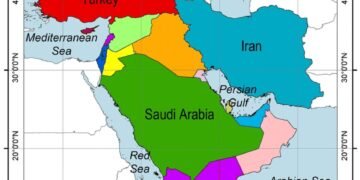The Trump administration has instructed two key intelligence agencies to enhance satellite surveillance along the U.S.-Mexico border, further intensifying efforts to combat illegal immigration and drug trafficking.
The National Geospatial-Intelligence Agency (NGA) and the National Reconnaissance Office (NRO), both operating under the Department of Defense, are now contributing satellite imagery and reconnaissance data to border security operations. Traditionally focused on military intelligence abroad, their involvement underscores a growing militarization of the southern border, where President Donald Trump declared a national emergency.
It remains unclear whether these agencies will collect imagery solely on foreign territory or if U.S. soil will also be monitored. While the White House and the Pentagon declined to comment, the NGA confirmed it had established a task force dedicated to border operations, and the NRO acknowledged its collaboration with intelligence and defense agencies to “secure U.S. borders.”
This expanded surveillance effort aligns with Trump’s broader crackdown on unauthorized migration, which includes executive orders targeting illegal border crossings and an estimated 14 million undocumented immigrants in the U.S. The administration has already deployed AI and drone technology for border security, but integrating advanced military surveillance capabilities marks a significant escalation.
Legal and Privacy Concerns
The initiative raises questions about privacy and legal boundaries. U.S. laws restrict intelligence agencies from spying on American citizens, but immigration enforcement authorities have broader leeway within 100 miles of the border—a zone encompassing major cities like San Diego and El Paso.
Legal experts caution that the administration must ensure compliance with these restrictions. Paul Rosenzweig, a national security attorney, emphasized that intelligence agencies should only gather data from foreign territory, but the implementation remains an area of concern.
A spokesperson for the Office of the Director of National Intelligence insisted that all intelligence operations are conducted legally and in accordance with privacy protections. However, the NGA and NRO declined to specify whether surveillance would include U.S. territory.
The CIA, which is prohibited from engaging in domestic law enforcement, is not involved in the effort, a source confirmed.
The Rise of a ‘Digital Border Wall’
As border security climbs higher on the administration’s intelligence priorities, the government is increasingly leveraging advanced technology to augment physical barriers. A recent U.S. intelligence report identified transnational crime—such as drug trafficking organizations—as a greater national security threat than countries like North Korea or Iran.
Defense contractors, both established firms and newer players, are actively pursuing contracts to support the administration’s high-tech border initiatives. These projects involve AI-driven analytics, sensor networks, and integrated surveillance systems to detect and track unauthorized movements.
Companies like Palantir and Anduril are already involved in cutting-edge surveillance projects. Palantir, a data analytics powerhouse, operates the Pentagon’s Maven Smart System, which uses AI to rapidly analyze and identify security threats. Anduril has deployed 300 autonomous surveillance towers for U.S. Customs and Border Protection, capable of detecting movement through radar and advanced imaging.
There is growing speculation that Palantir, Anduril, SpaceX, and other tech firms may form a consortium to challenge traditional defense contractors for future government security contracts. While representatives from Palantir and Anduril declined to comment, SpaceX did not respond to inquiries.
The administration’s ultimate goal, according to insiders, is to develop a sophisticated “digital wall” that integrates AI, satellite surveillance, and autonomous systems—potentially reshaping the future of border security in the U.S.

 English
English






































